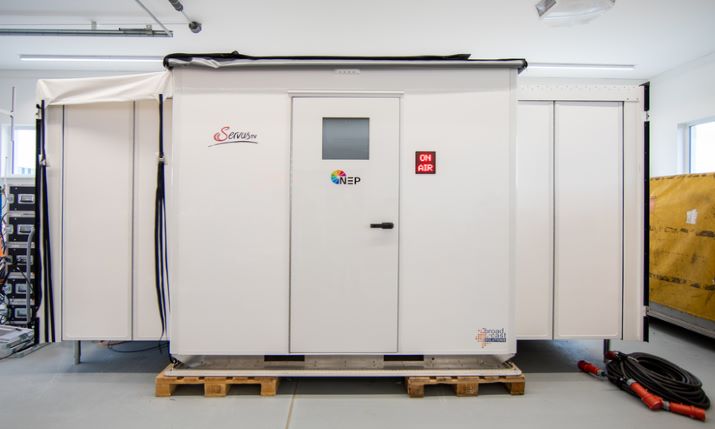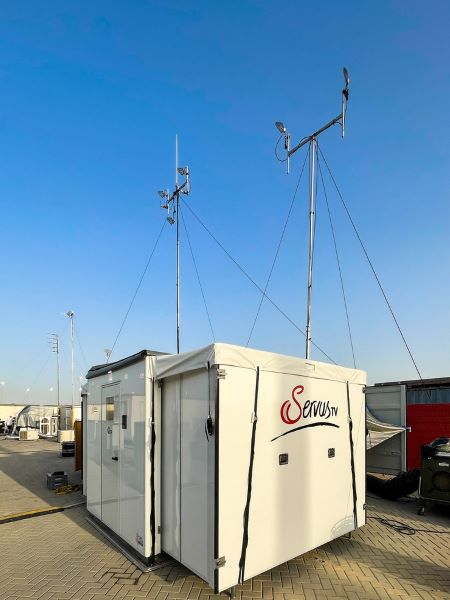NEP Germany moves into air freight pods for Servus TV’s Formula 1 season production

NEP Germany has created a mobile production studio exclusively for its client Servus TV, installed in an extendable air freight container that NEP developed together with Broadcast Solutions
NEP Germany is using a new air freight-friendly container solution to enable its production of the current Formula 1 season for Austrian broadcaster Servus TV.
To have an optimal and quickly operational production solution at the track, NEP Germany has created a new pod that will enable it to transmit signals from trackside to Servus TV, which acquired Formula 1 rights from this season onwards.
Production service provider to the Austrian network, NEP Germany has created the mobile production studio exclusively for its client, installed in an extendable air freight container that NEP developed together with Broadcast Solutions.
Interacting with additional air freight containers that function as set-up vehicles, they are now travelling around the world during the Formula 1 season.
The pod is primarily used to produce interviews and expert talks, which are captured by two wireless camera teams and one EB team around the track or in the pit lane. The configuration is customised specifically for Formula 1 purposes.

NEP Germany’s pod accommodates all the essential technical components used for a TV production in an OB van, but in the smallest possible space
New build concept
Matthias Hahn, project manager at Broadcast Solutions, told SVG Europe that the pod was an entirely new idea for the company: “We have built flightcase studios, OB vans, hybrid OB vans and mobile studios in containers before, but to integrate a studio in an expandable air fright container is a new concept.”
Mark Overkamp, technical director at NEP Germany, explained the background behind the pods: “Because of the excessive travelling involved in the production of Formula 1, we needed a highly mobile, transportable solution that could provide all the technology for our productions in the smallest possible space and still make it comfortable to work in.
“Together with Broadcast Solutions, with the pod we have developed a solution that, in combination with a sophisticated stagebox concept, optimally supports us in the current productions but also leaves options open for the future.”
Hahn commented on the challenges faced by Broadcast Solutions during the build: “The main challenges besides the short time for building them (due to the contract from Servus TV to NEP Germany) were of course to integrate all the equipment in the pod. To offer four work places in a space of 14sqm (expanded) was another challenge. You have to keep in mind basic rules for workspace ergonomics plus air conditioning. Having a lot of experience in building mobile production units and being an air conditioning specialist helps a lot to solve those issues.”
“A further solution to the customers’ needs was the interplay between the pod as such and a sophisticated stagebox concept to make set up and working with the complete system as easy and reliable as possible. A further challenge was the interconnection to Servus TVs headquarter in Austria, near Salzburg. The pod is pre-equipped to be managed remotely from Salzburg,” said Hahn.
Smallest possible space
The pod accommodates all the essential technical components used for a TV production in an OB van, but in the smallest possible space. With two extensions, the pod can be enlarged from 7.5sqm to 14sqm and offers space for four workstations (1 audio engineer, 1 video engineer, 2 editorial staff), including a central technical rack with 2x 38 RU.
The pod is used to monitor the video and audio signals of the camera teams working on the production, as well as to control the intercom signals and the Motorola radio links. During the productions, the audio and video signals are transmitted directly from the race track via dark fibre to the Servus TV broadcasting centre in Salzburg, where the PGM signal is being created. The in-ear monitoring of the presenters, reporters and camera teams is managed in the pod to avoid audio delays.
The audio signals generated in this workflow are characterised by high heterogeneity. The pod and the WISYCOM transmitters, which realise the wireless network across the track, work with digital audio in the Dante format. The intercom signals are processed in AES67, and further analogue audio signals are coming from the office containers.
To ensure smooth conversion, several Prodigy multi-format converters from DirectOut, housed in stageboxes, convert analogue audio and AES67 to Dante and vice versa. A Yamaha QL1 digital audio console with Dante integration is used to mix the signals in the pod itself, where Riedel’s MicroN system works as the main router. For control of the audio and video signals, the Broadcast Solutions control system hi human interface runs in the pod.
Technically and in terms of workflows, the pod is designed to be ready for full remote control from the broadcasting centre in Salzburg.
The system already passed its first baptism of fire on 28 March at the Formula 1 Bahrain Grand Prix. The next event it will be used at will be the Italian Grand Prix in Imola on 18 April.
